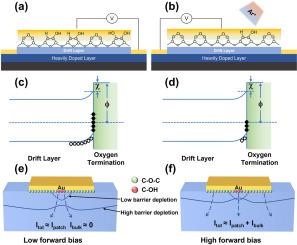Comprehensive performance analysis of diamond Schottky diodes with argon-ion-modified oxygen-terminated surfaces
IF 11.6
2区 材料科学
Q1 CHEMISTRY, PHYSICAL
引用次数: 0
Abstract
Oxygen termination on diamond surfaces plays a critical role in determining the performance of diamond-based electronic and biosensing devices. However, limited insights into oxygen-terminated diamond surfaces have constrained further performance improvements. To bridge this gap, the current study developed a novel oxidation methodology, which enhanced both oxygen coverage and device performance. Current-voltage (I–V) and capacitance-voltage (C–V) measurements confirmed improved electrical characteristics. X-ray photoelectron spectroscopy (XPS) revealed increased oxygen coverage and reconstruction of the oxygen-terminated surfaces. Kelvin probe force microscopy (KPFM) verified the homogenous surface potential distribution following oxidation. The presence of acceptor interface states was further confirmed using KPFM under dark and ultraviolet illumination. Additionally, density functional theory (DFT) calculations provided theoretical support for the observed surface reconstruction and performance enhancement. Overall, the I–V, C–V, XPS, KPFM, and DFT analysis collectively establish correlations between oxygen termination composition, interface states, and Schottky barrier diode performance, offering new pathways for the optimization of diamond-based devices.

氩离子修饰端氧面金刚石肖特基二极管的综合性能分析
金刚石表面的氧终止在决定金刚石基电子和生物传感器件的性能方面起着关键作用。然而,对氧端化金刚石表面的有限了解限制了进一步的性能改进。为了弥补这一差距,目前的研究开发了一种新的氧化方法,提高了氧气覆盖率和设备性能。电流电压(I-V)和电容电压(C-V)测量证实了电气特性的改善。x射线光电子能谱(XPS)显示氧覆盖增加和重建的氧终止表面。开尔文探针力显微镜(KPFM)证实了氧化后表面电位分布均匀。在黑暗和紫外线照射下,用KPFM进一步证实了受体界面态的存在。此外,密度泛函理论(DFT)计算为观测表面重建和性能增强提供了理论支持。总体而言,I-V, C-V, XPS, KPFM和DFT分析共同建立了氧终止成分,界面状态和肖特基势垒二极管性能之间的相关性,为优化金刚石基器件提供了新的途径。
本文章由计算机程序翻译,如有差异,请以英文原文为准。
求助全文
约1分钟内获得全文
求助全文
来源期刊

Carbon
工程技术-材料科学:综合
CiteScore
20.80
自引率
7.30%
发文量
0
审稿时长
23 days
期刊介绍:
The journal Carbon is an international multidisciplinary forum for communicating scientific advances in the field of carbon materials. It reports new findings related to the formation, structure, properties, behaviors, and technological applications of carbons. Carbons are a broad class of ordered or disordered solid phases composed primarily of elemental carbon, including but not limited to carbon black, carbon fibers and filaments, carbon nanotubes, diamond and diamond-like carbon, fullerenes, glassy carbon, graphite, graphene, graphene-oxide, porous carbons, pyrolytic carbon, and other sp2 and non-sp2 hybridized carbon systems. Carbon is the companion title to the open access journal Carbon Trends. Relevant application areas for carbon materials include biology and medicine, catalysis, electronic, optoelectronic, spintronic, high-frequency, and photonic devices, energy storage and conversion systems, environmental applications and water treatment, smart materials and systems, and structural and thermal applications.
 求助内容:
求助内容: 应助结果提醒方式:
应助结果提醒方式:


